Modar Tutorial
Example 4: Villin headpiece in explicit water box
- This example shows how to use Modar to setup a protein (Villin headpiece, denotes HP36) equilibrating in water starting from a scratch.
- Then its unfolding process by heat will be investigated.
- This example can be found in folder "Example/villin" in Modar prebuilt binary package.
- 很抱歉,没时间写中文版了,请大家凑和看,有问题请随时和我联系 chenmengen@gmail.com 。
Here is the procedures step-by-step
Preparations
- HP36 is composed of three helices (residues Asp44-Lys48, Arg55-Phe58 and Leu63-Lys70) which are packed together to share a hydrophobic core mainly contributed by the phenylalanine and leucine residues as shown in bellow figure. The three helices are connected by a loop (residues Ala49-Thr54) and a turn (residues Ala59 to Pro62) (McKnight, C. J., Matsudaira, P. T., and Kim, P. S. (1997) NMR structure of the 35-residue villin headpiece subdomain, Nature Structural Biology 4, 180-184). It’s known that HP36 folds on the microsecond timescale and is very thermostable. Its small size and rapid folding have made it an exceptionally popular model protein for theoretical and computational studies of protein folding and dynamics.

- We need an initial structure of the protein, which can be downloaded from RCSB protein data bank, go website http://www.pdb.org and search with keyword “villin headpiece”, then go entry “1VII” to download the PDB file.
- For information about PDB foramt, please refer to documentation on RCSB website.
- We have the files in the folder at beginning:
Filename
File Type
Description
1VII.pdb
Text
The protein initial structure file (solved by NMR) downloaded form RCSB
waterbox.msf
Text
A pre-build water solvent system in a cubic shape
modar
or:
modar.exe (forWindows)executable
The primary Modar executable binary
viewene
or:
viewene.exe (forWindows)executable
The utility for viewing the energies profile generated by modar
step1_build_solute.inp
script
The Modar script for describing protein in FF
step2_gen_solvbox.inp
script
for building a water box
step3_add_ions.inp
script
for adding and placing contour ions
step4_merge.inp
script
for putting protein and ions to the water box
step5_minimize.inp
script
for optimizing the system by energy minimization
step6_heatup.inp
script
for heating up the system to temperature desired
Step7_equil_nvt.inp
script
for running a short equilibration with NVT condition
step8_equil_npt.inp
script
for running a short equilibration with NPT condition
step9_equil_npt_more.inp
script
for building a compact MD core for further long scale time simulation
step10_heat_to_500k.inp
Script
For heating to 500K
step11_unfolding.inp
Script
Unfolding
calc_rmsd.inp
Script
For RMSD profile analysis
calc_rmsd2.inp
Script
For unfolding pathway analysis
do_pdb_nomination_replacement.inc
Script
For PDB to Modar nomination replacement
do_protein_dna_rna_terminals_patch.inc
Script
For protein, RNA, DNA terminus patching
loadff.inc
Script
Load Charmm force field
nptc.inc
Script
NPT ensemble setup with Nose-Hoover Thermostat and Langevin Piston pressure coulpling
Step 1. Describe the protein in CHARMM force field by command:
where,
Or, just simply by command if you don't want the interactive prompt.
|
- Please read the scipt file "step1_build_solute.inp" for more details. This script file is general template for interprelating protein, RNA and DNA. Please read the comments (in green) first before doing a practice and pay attension to the lines marked in red color.
- The output files will be
Filename
File Type
Description
step1_build_solute.log
Text
The log message produced by Modar
step1_solute.msf
Text
Solute structure file in Modar format described in FF given
step1_solute.pdb
Text
Solute structure file in RCSB PDB format
solute_size.inc
Text
The extension of solute in Modar assign statement
-
Some log message would be printed on screen (step1_osl.html)
Step 2. Generate a water box by command:
|
Or without argument “boxtype=cubic a=60”, it will ask you for box type and a,b,c respectively.
- Please read the scipt file "step2_gen_solvent_box.inp" for more details about these options.
- The output files will be:
Filename
File Type
Description
step2_gen_solvent_box.log
Text
The log message produced by Modar
step2_solvbox.msf
Text
The solvent structure file in Modar format described in FF given
step2_solvbox.pdb
Text
Solvent structure file in RCSB PDB format
pbc.inc
Text
The PBC setup for further usage
Step 3. Add counter ions by command:
Or without argument “method=hybrid ionc=0.1”, it will ask you for which approach to use for adding ions and the salt concentration desired. |
- Please read the scipt file "step3_add_ions.inp" for more details.
- The output files will be:
Filename
File Type
Description
step3_add_ions.log
Text
The log message produced by Modar
step3_with_ions.msf
Text
Solute with ions structure file in Modar format described in FF given
step3_with_ions.pdb
Text
Solute with ions structure file in RCSB PDB format
-
Some log message would be printed on screen (step2_osl.html).
Step 4. Put solute and salt to the water box by command:
|
- Please read the scipt file "step4_merge_all.inp" for more details. This scrip file could serve as tempelate script for merging several MSF file together.
- The output files will be:
Filename
File Type
Description
step4_merge_all.log
Text
The log message produced by Modar
step4_all.msf
Text
The whole MD system structure in Modar MSF format file
step4_all.pdb
Text
The whole MD system structure in RCSB PDB format file
-
Some log message would be printed on screen (step4_osl.html).
- Please view the system by command:
./movar step4_all.pdb - Here is the whole MD system snaped by Movar
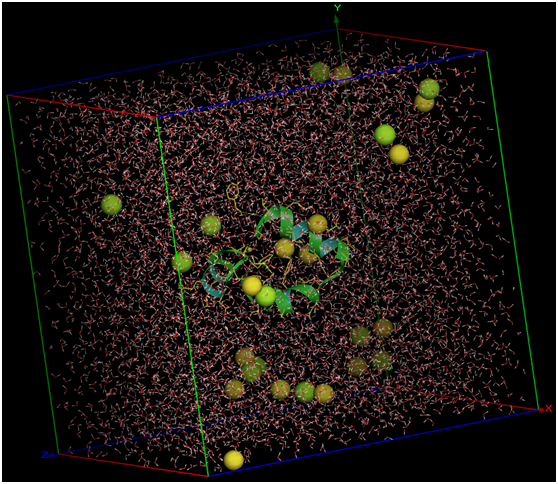
Step 5. Do a serial of energy minimization by command:
|
- Please read the scipt file "step5_do_minimization.inp" for more details.
- The output files will be:
Filename
File Type
Description
step5_do_minimization.log
Text
The log message produced by Modar
step5_minimized.msf
Text
The whole MD system structure minimized in Modar MSF format file
step5_minimized.pdb
Text
The whole MD system structure minimized in RCSB PDB format file
step5_min?.trj
Binary
The trajectory file in Modar format for every minimization stage respectively
step5_min?.ene
Binary
The energy profile for every minimization state respectively, and it can be viewed by tool “viewene”
miniport.txt
Text
The potential energy profile extracted from the log file for the whole minimization progress.
-
Plot the file “miniport.txt” should get a picture as shown bellow.
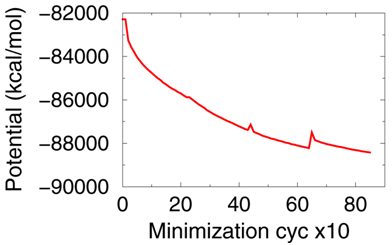
Step 6. Heatup the system by command:
We’ll heatup the system to 300K through Berendsen thermostat approach and equilibrate the system somehow. |
- Please read the scipt file "step6_heatup.inp" for more details.
- The output files would be:
Filename
File Type
Description
step6_heatup.log
Text
The log message produced by Modar
step6_heatup.mds
Text
The whole MD system steup in Modar MDS format file
step6_heatup.pdb
Text
The whole MD system structure heatuped in RCSB PDB format file
step6_heatup.trj
Binary
The trajectory file in Modar format for heating up progress
step6_heatup.ene
Binary
The energy profile of the heating up progress
step6_heatup.rst
Binary
The system state for further simulation
- Please check the energy profile by command:
./viewene step6_heatup.ene
As shown in bellow pictures, the system has been tempering from 50K to 300K gradually.

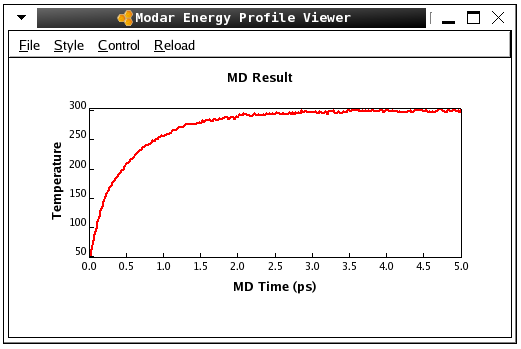
Step 7. Run a short NVT equilibration by command:
Here, we equilibrate the system under NVT condition with Nose-Hoover thermostat method. |
- Please read the scipt file "step7_equil_nvt.inp" for more details.
- The output files will be:
Filename
File Type
Description
step7_equil_nvt.log
Text
The log message produced by Modar
step7_equil_nvt.mds
Text
The whole MD system steup in Modar MDS format file
step7_equil_nvt.pdb
Text
The whole MD system structure in RCSB PDB format file
step7_equil_nvt.trj
Binary
The trajectory file in Modar format for equilibrating progress
step7_equil_nvt.ene
Binary
The energy profile of the equilibrating progress
step7_equil_nvt.rst
Binary
The system state for further simulation
- Please check the energy profile by command
./viewene step7_equil_nvt.ene
The poteintial and temperature fluctuation would be something as shown in bellow picture.

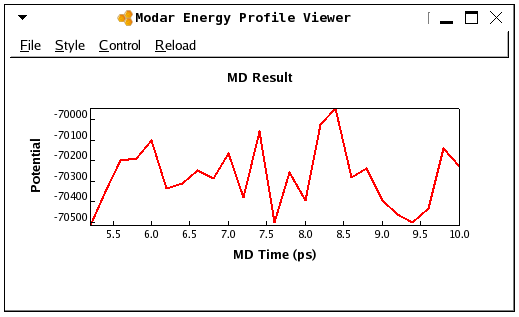
Step 8. Run a short NPT equillibration by command:
Here, we run a short NPT equilibration with Nose-Hoover thermostat for temperature control and Langevin piston method for pressure coupling. |
- Please read the explanation of the scipt file "step8_equil_npt.inp" for more details.
- The output files will be:
Filename
File Type
Description
step8_equil_npt.log
Text
The log message produced by Modar
step8_equil_npt.mds
Text
The whole MD system structure in Modar MSF format file
step8_equil_npt.pdb
Text
The whole MD system structure in RCSB PDB format file
step8_equil_npt.trj
Binary
The trajectory file in Modar format for the progress
step8_equil_npt.ene
Binary
The energy profile of the progress
step8_equil_npt.rst
Binary
The system state for further simulation
Step 9. Resume a 2ns NPT equilibration by command:
|
Or we could set argument “nstep=0” to build the MD core only, then submit job to compute node to run job by command:
|
- Please read the explanation of the scipt file "step9_equil_npt_more.inp" for more details.
- The output files will be:
Filename
File Type
Description
step9_equil_npt_more.log
Text
The log message produced by Modar
step9_equil_npt_more.mds
Text
The whole MD system steup in Modar MDS format file
step9_equil_npt_more.trj
Binary
The trajectory file in Modar format for the progress
step9_equil_npt_more.ene
Binary
The energy profile of the progress
step9_equil_npt_more.rst
Binary
The system state for further simulation
Step 9.1. Calculate the RMSD profile by command:
|
-
In this step, we’ll add a water phase to the system.
- Please read the explanation of the scipt file "calc_rmsd.inp" for more details.
- The output files will be:
Filename
File Type
Description
rmsd.txt
Text
The overall RMSD
bbrmsd.txt
Text
The backbone RMSD
-
The backbone RMSD fluctaion should be similar to the bellow picture, the backbone RMSD is in black, and the overall RMSD is in red.
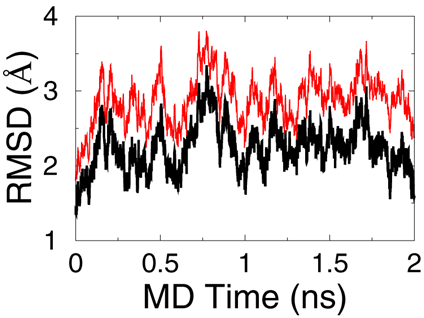
Step 10. Heaup the system to 500K under NVT condition,
then do a short NVT equilibration and also a short NTP equilibration
by command:
|
- Please read the explanation of the scipt file "step10_heat_to500k.inp" for more details.
- The output files will be:
Filename
File Type
Description
step10_heat_to400k.trj
step10_equil_nvt.trj
step10_equil_npt.trj
Binary
The trajectory file in Modar format for the progress
step10_heat_to400k.ene
step10_equil_nvt.ene
step10_equil_npt.ene
Binary
The energy profile of the progress
step10_heat_to400k.rst
step10_equil_nvt.ene
step10_equil_npt.ene
Binary
The system state for further simulation
step10_equil_npt.mds
Binary
The whole MD system steup in Modar MDS format file
Step 11. Continue for 10 ns NPT simulation to unfolder the protein by command:
Or run the command without argument “nstep=2500000” to build the MD setup only, then run the job on a HPC by command
The job may take a whole day on a laptop, so it’s better to submit the job to a HPC. |
- Please read the explanation of the scipt file "step11_unfolding.inp" for more details.
- The output files will be:
Filename
File Type
Description
step11_unfolding.trj
Binary
The trajectory file in Modar format for the progress
step11_unfolding.ene
Binary
The energy profile of the progress
step11_unfolding.rst
Binary
The system state for further simulation
step11_unfolding.log
Binary
The log file
- The RMSD profile can be computed using the same script “calc_rmsd.inp” used in step9 by command.
./modar calc_rmsd.inp msf=step6_heatup.msf \ mds=step9_equil_npt_more.mds \ pdb=step5_minimized.pdb \ trj=step10_unfolding.trjThe RMSD profile in my simulation:
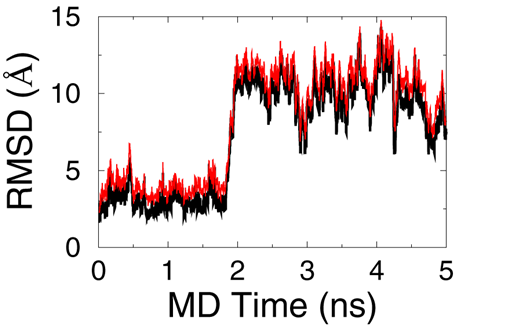
Step 12. Unfolding pathway analysis by command:
|
- Please read the scipt file "calc_rmsd2.inp" for more details.
- The output files will be:
Filename
Description
bbrmsd_h1.txt
backbone RMSD profile of Helix 1 (seq 43:51)
bbrmsd_h2.txt
backbone RMSD profile of Helix 2 (seq 54:61)
bbrmsd_h3.txt
backbone RMSD profile of Helix 3 (seq 62:73)
bbrmsd_h12.txt
backbone RMSD profile of Helix 1&2 (seq 43:61)
bbrmsd_h23.txt
backbone RMSD profile of Helix 2&3 (seq 54:73)
- Bellow is the plot of file “bbrmsd_h1.txt”, “bbrmsd_h2.txt”, “bbrmsd_h3.txt”.
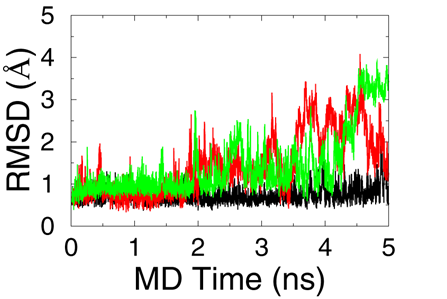
- Bellow is the plots of file “bbrmsd_h12.txt” and “bbrmsd_h23.txt”
Obviously, the unfolding pathway for my simulation is: the turn between Helix 2 and Helix 3 opened first, and then helix 2 and 3 opened respectively, the N-terminal helix is the most stable part.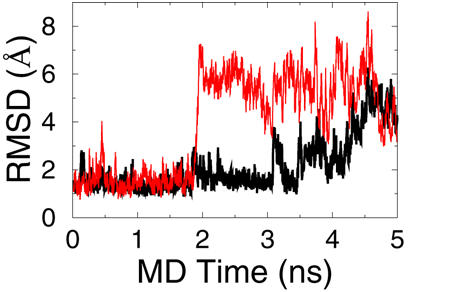
Summary
- In this example, we practise a protein simulation in a explicit water solvent, the system was equilibrated 2ns at room temperature under NPT ensemble, then the unfolding pathway was investigated through the NPT equilibrating simulation at high temperature 500K.
Computational detail
- The MD system was modeled in CHARMM 27 force field.
- Berendsen weak temperature coupling method were used for tempering process.
- Nose-Hoover thermostat approach was used for keeping constant temperature in NVT and NPT equilibrating simulations, the Langevin piston approach was used for constant pressure coupling.
- Shake constraint method was applied for all hydrogen relatived bonds in all simulation.
- The long range electrostatic interactions were evaluated precisely through PME algorithm, and the short range interactions were truncated at 10.0 angstrom with a switch function.
- All simulations were propograted using leapfrog integrator with a time step 2fs, and samples were collected for every 1ps second.
Contact us
| Phone: | 400-660-8656 | |
| Email: | support@beemd.org |
我们长期和北京市计算中心合作提供计算培训服务,承接托管计算业务,如有需求请随时联系我们。